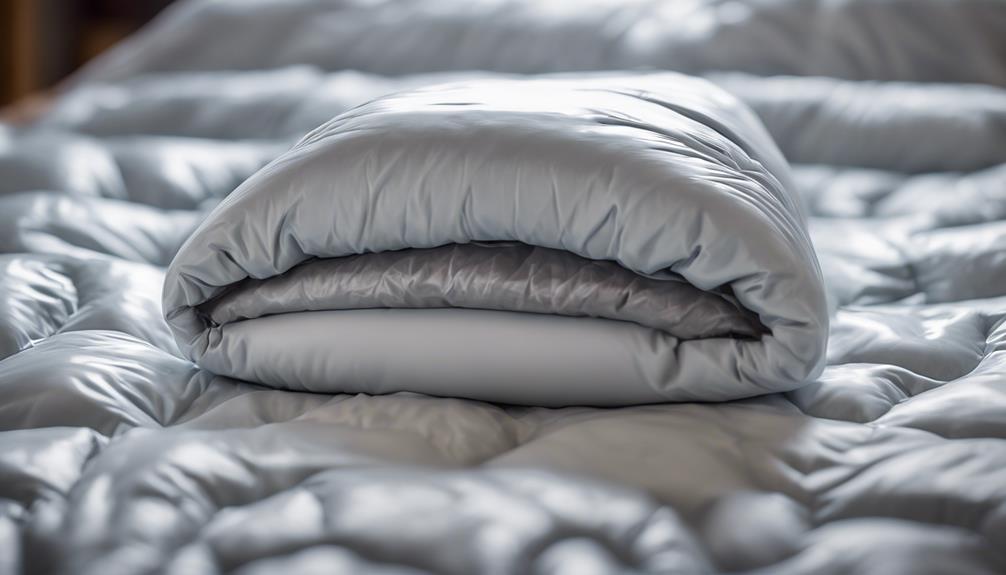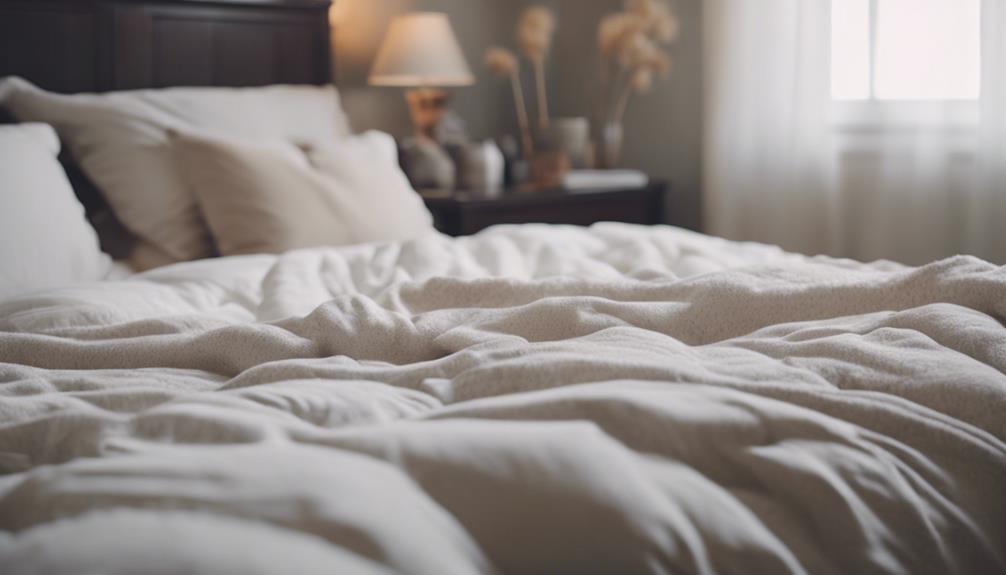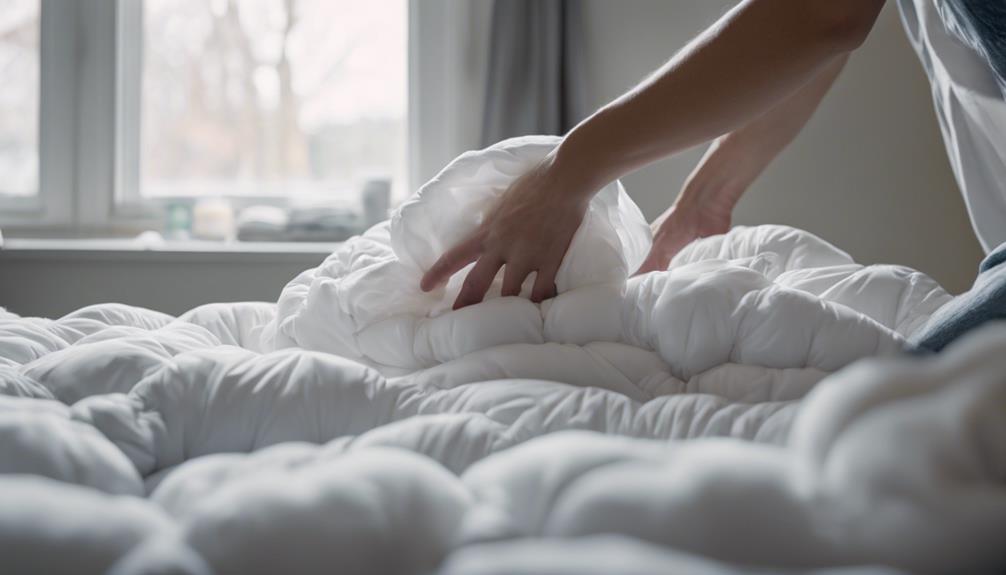Vacuum sealing bags can affect the fluffiness and insulation of comforters, potentially compromising their loftiness and warmth retention. Excessive compression in these bags may result in decreased loft and reduced insulation effectiveness over time. To maintain the quality of your comforter, it is important to strike a balance between saving space and preserving its comfort. It is recommended to refrain from using vacuum seal bags for down or feather bedding to avoid damage. Additionally, clumping of comforter fibers can disrupt the distribution of warmth, underscoring the importance of utilizing proper storage techniques. Consider alternative storage methods and handle comforters gently to ensure their longevity and continued coziness. For more information on how to preserve comforter quality and avoid common mistakes when vacuum sealing, click here.
Key Takeaways
- Vacuum-seal bags can ruin comforters by compressing them excessively and compromising their fluffiness.
- Excessive compression diminishes insulation, reducing warmth retention in comforters.
- Fiber clumping may occur, disrupting warmth distribution within the comforter.
- Avoid vacuum-sealing down comforters to prevent damage to delicate feathers.
- Opt for non-compression storage bags to preserve comforter quality and longevity.
Potential Impact on Comforter Fluffiness
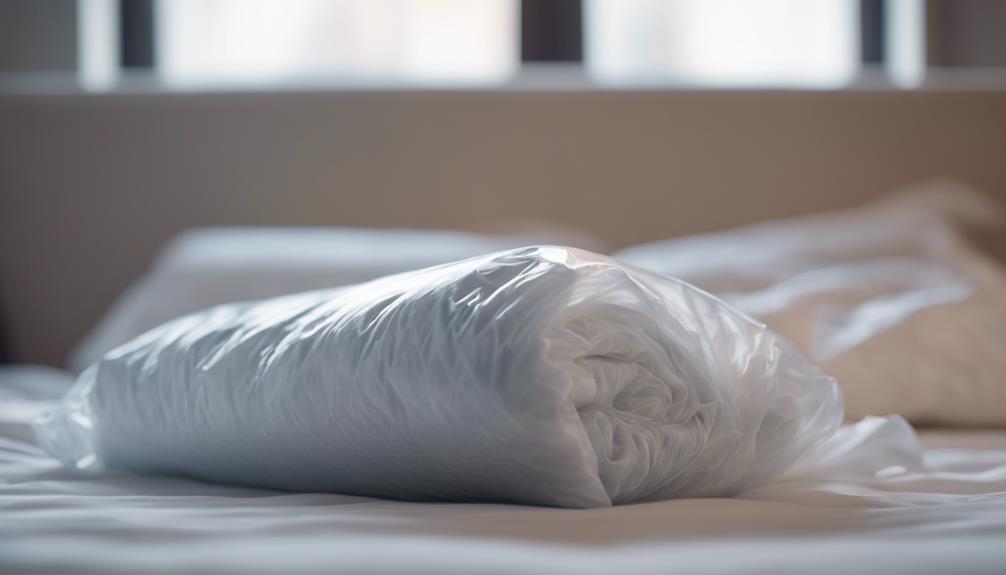
When vacuum-sealing comforters, the compression can greatly affect their fluffiness and overall quality. Excessive compression in vacuum bags may lead to a loss of loft, making the comforter appear flat and less cozy. The natural loftiness of the comforter, especially those filled with down or feathers, can be compromised due to the pressure exerted by the vacuum seal. As the comforter gets compressed, the air pockets within the filling material collapse, resulting in a less fluffy and voluminous appearance.
It is important to be mindful of the level of compression when vacuum-sealing comforters to preserve their fluffiness. Following guidelines on how tightly to seal the bags can help prevent damaging the comforter's overall quality. By ensuring that the comforter isn't overly compressed, you can maintain its fluffiness and ensure that it remains inviting and comfortable to use. Remember, striking the right balance between vacuum-sealing for storage and preserving the comforter's fluffiness is key to prolonging its lifespan and enjoyment.
Effects on Comforter Insulation
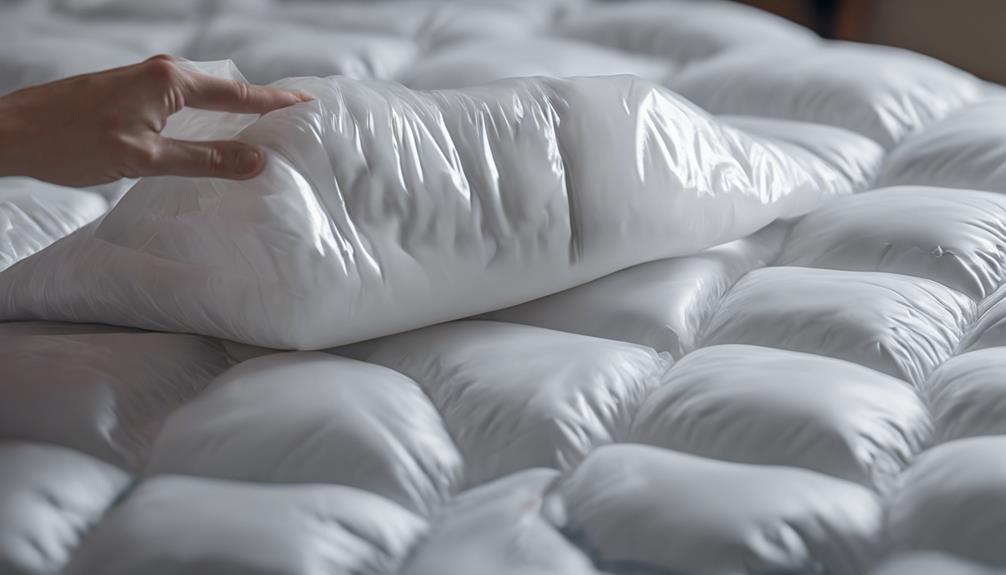
When vacuum-sealing comforters, we should be wary of the potential effects on their insulation. The compression caused by vacuum bags can diminish the comforters' ability to trap heat efficiently, impacting their overall warmth.
Over time, this compression may lead to a breakdown of the fibers, further reducing the comforter's insulation properties.
Insulation Compression Concerns
Vacuum sealing comforters can potentially diminish their insulation effectiveness by compressing the fibers, affecting their loft and fluffiness. When comforters are squashed into vacuum seal bags, the compression can compromise their original insulation properties.
This compression may lead to a decrease in warmth retention, as the fibers are unable to provide the same level of insulation when flattened. It's important to take into account this impact on comforter insulation before opting for vacuum sealing.
While the bags can save space, the trade-off might be a reduction in the comforter's ability to retain heat efficiently. To maintain ideal insulation and comfort, it's crucial to strike a balance between space-saving measures and preserving the comforter's loft and fluffiness.
Long-Term Fluff Loss
Indefinitely, excessive compression from vacuum seal bags can lead to long-term fluff loss in comforters, diminishing their insulation effectiveness over time. When comforters are squashed down for extended periods in vacuum storage bags, the filling inside can become permanently compacted, resulting in decreased fluffiness.
This compression damages the comforter's ability to trap heat and maintain warmth, affecting its overall comfort and performance. To prevent long-term fluff loss and preserve the insulation quality of your comforter, it's advisable to avoid using vacuum seal bags for storage, especially for down or feather bedding.
Opting for breathable fabric storage bags or simply airing out and fluffing your comforter regularly can help maintain its original loft and comfort level.
Fibers Breakdown Risk
Excessive compression from vacuum seal bags poses a significant risk to the breakdown of fibers in comforters, ultimately compromising their insulation effectiveness. When comforters are vacuum sealed, the pressure can cause the fibers to weaken and break down over time.
This breakdown affects the loft of the comforter, reducing its ability to trap heat and keep you warm. The insulation properties of the comforter diminish as the fibers deteriorate, leading to a decrease in overall warmth and fluffiness.
With each cycle of compression in vacuum seal bags, the risk of fibers breaking down increases. To preserve the quality and longevity of your comforter, it's advisable to avoid using vacuum seal bags that excessively compress the fibers, ensuring your comforter maintains its insulation capabilities.
Clumping of Comforter Fibers
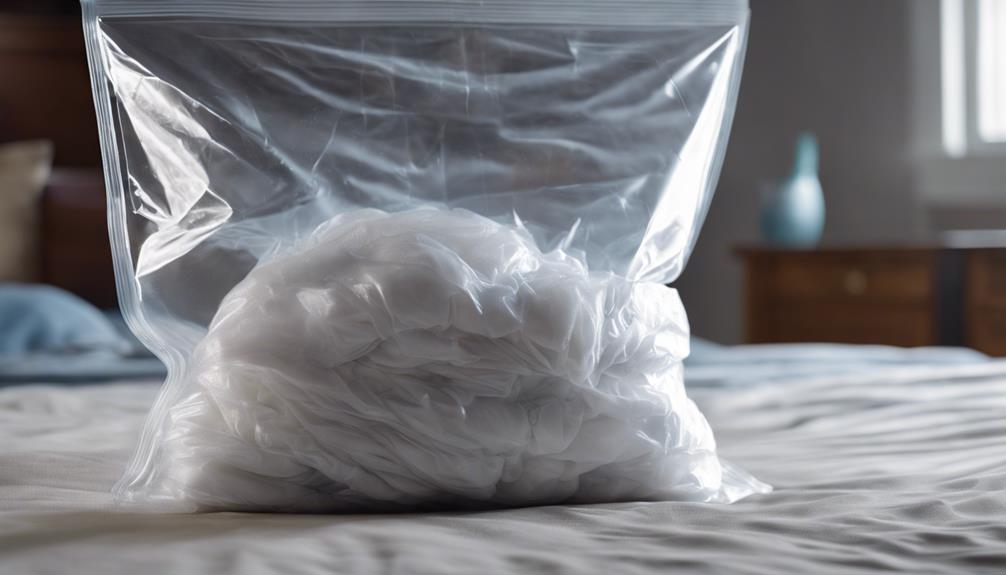
When comforter fibers clump in vacuum seal bags, it can disrupt the even distribution of warmth and comfort, affecting the overall quality of the bedding.
To prevent this issue, it's important to follow proper storage techniques and avoid over-compressing the comforter.
Maintaining the fluffiness and loftiness of the comforter is vital for preserving its insulation properties and ensuring a cozy night's sleep.
Fiber Clumping Prevention
To prevent fiber clumping in comforters, it's essential to avoid compressing the fibers too tightly when using vacuum seal bags. Vacuum storage bags can lead to clumping of comforter fibers if the fibers are overly compressed. This compression can cause the fibers to stick together, resulting in uneven distribution within the comforter and potential lumps forming.
To prevent this issue, it's vital to gently pack the comforter into the vacuum seal bag, allowing some room for the fibers to remain fluffy and uncompressed. By avoiding excessive compression, you can maintain the loftiness and overall quality of your comforter, ensuring that it retains its insulation properties effectively.
Fluffiness Maintenance Tips
Maintaining the fluffiness of a comforter can be challenging when stored in vacuum seal bags for extended periods, as the compression of fibers may lead to clumping.
To combat this issue, it's crucial to air out and shake the comforter regularly after removing it from a vacuum storage bag. By doing so, you help redistribute the filling and prevent fibers from settling and forming clumps.
Additionally, consider using alternative storage methods that allow the comforter to maintain its loftiness. Avoiding long-term compression in vacuum seal bags is crucial to preserving the fluffiness of the comforter.
These maintenance tips can help make sure that your comforter remains fluffy and comfortable for a longer period.
Storage Best Practices
How can storage practices impact the fluffiness of your comforter fibers?
When it comes to maintaining the loft and comfort of your comforter, it's important to be mindful of storage methods. Vacuum-seal storage or storing comforters in plastic bags can lead to clumping of the fibers.
The tight compression from these storage options can damage the fluffiness of the comforter over time, resulting in uneven distribution of warmth and comfort when using it.
To prevent fiber clumping and preserve the quality of your comforter, it's advisable to avoid extended periods of storage in vacuum-sealed bags. Instead, opt for breathable storage solutions like cotton bags or bins.
Long-Term Warmth and Comfort Issues
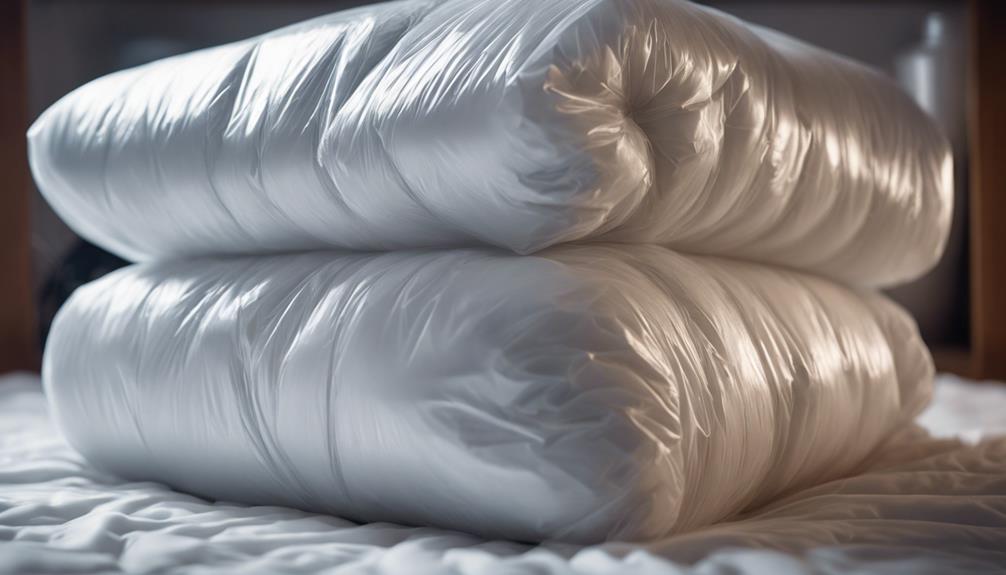
When storing comforters in vacuum seal bags, their long-term warmth and comfort may be compromised due to compression and reduced fluffiness. The compression caused by vacuum storage bags can lead to down or feathers in the comforters clumping together, resulting in uneven distribution and decreased insulation.
As time passes, the fibers within the comforters, compressed by these bags, may lose their loftiness, affecting their ability to effectively trap heat and maintain warmth. Compared to breathable storage containers that allow for proper airflow, vacuum-sealed comforters may not offer the same level of comfort and coziness.
To maintain the desired warmth and comfort of your comforters in the long run, it's advisable to avoid vacuum seal bags and opt for breathable storage solutions instead. By selecting the appropriate storage method, you can help preserve the fluffiness and insulation of your comforters for extended periods, ensuring they continue to provide the desired warmth and comfort.
Considerations for Down Comforters
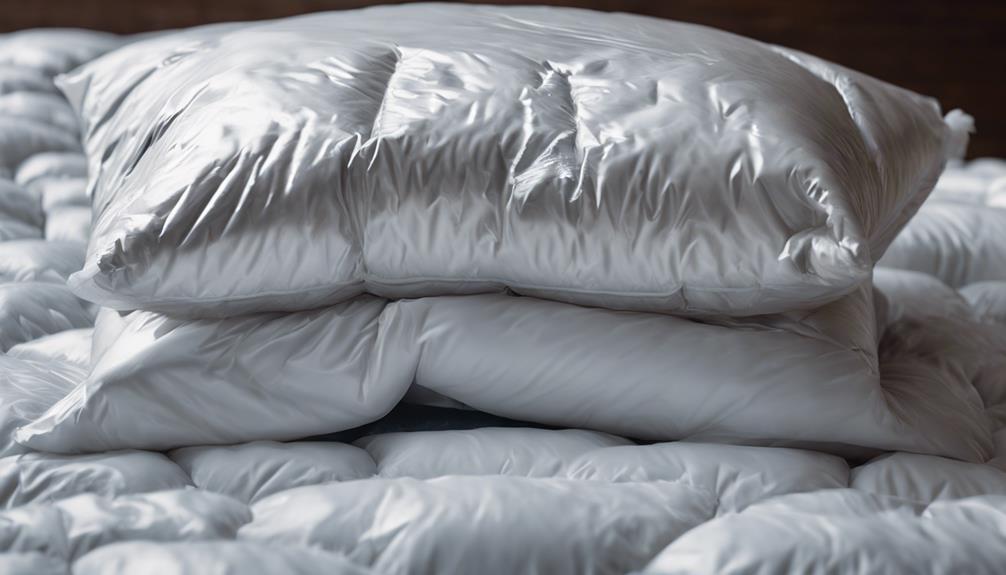
Moving on from the discussion on long-term warmth and comfort issues when storing comforters in vacuum seal bags, it's essential to take into account specific factors related to down comforters.
Down comforters, also known as feather duvets, shouldn't be stored in vacuum seal bags due to the potential damage it can cause to the delicate feathers. The compression from vacuum sealing may harm the insulation effectiveness and ruin the fluffiness of down comforters. The full feathers in down comforters have brittle quills that can snap when compressed in vacuum bags, leading to a decrease in quality over time.
To maintain the loft and effectiveness of down comforters, it's recommended to use non-compression storage bags specifically designed for this purpose. For instance, Neusu offers specialized storage bags that don't compress the feathers, ensuring the longevity and quality of your down comforter.
Impact on Synthetic Fiber Comforters
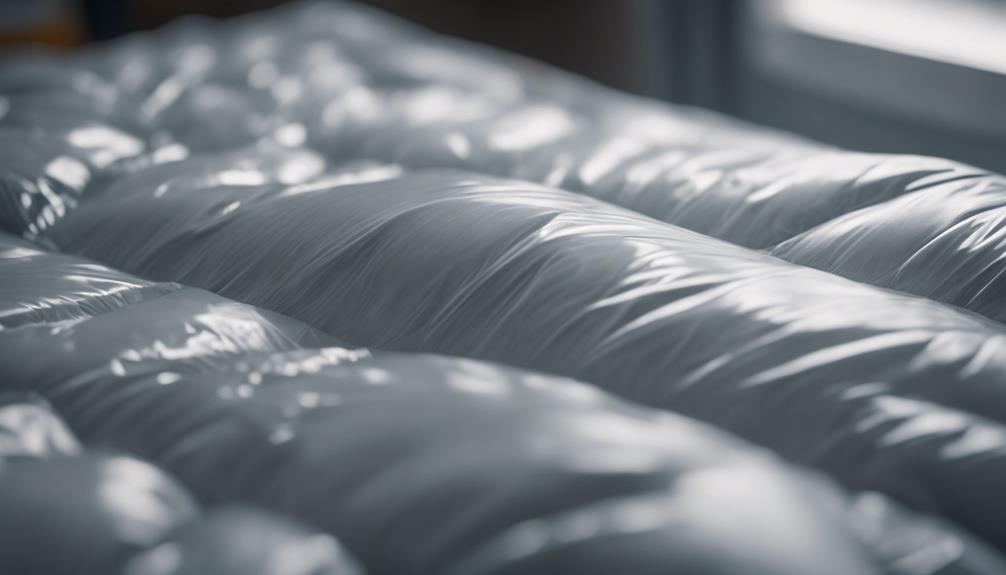
When vacuum-sealing synthetic fiber comforters, it's important to think about how the compression may affect their fluffiness and overall comfort.
Additionally, understanding the long-term storage implications of vacuum sealing on synthetic fiber comforters is vital for maintaining their quality over time.
Fiber Compression Effects
Compressing synthetic fiber comforters in vacuum seal bags can greatly reduce their loft and fluffiness, diminishing their insulating properties and potentially damaging their structure. When these comforters are vacuum sealed, the air trapped within the fibers gets removed, causing them to flatten and lose their original shape.
This compression not only affects their softness and comfort but also hampers their ability to provide warmth. Over time, excessive compression in vacuum storage bags can lead to permanent damage to the synthetic fibers, impacting the overall quality and longevity of the comforter.
Hence, it's advisable to avoid vacuum sealing synthetic fiber comforters to maintain their loft, fluffiness, and insulating properties for the best comfort and performance.
Long-Term Storage Considerations
Storing synthetic fiber comforters in vacuum seal bags can effectively preserve their quality and fluffiness over extended periods. When utilizing vacuum storage bags, it's crucial to make sure that all excess air is removed before sealing.
By removing air from the bags, synthetic fiber comforters can be protected from dust and pests, maintaining their cleanliness and durability. The compression experienced in vacuum seal bags doesn't negatively impact synthetic fiber comforters, as they're resilient to such pressure.
Properly sealed vacuum bags can help maintain the loftiness and overall quality of synthetic fiber comforters, making them suitable for long-term storage. This method is a practical and efficient way to keep your comforters in good condition for an extended period.
Alternative Storage Methods for Comforters
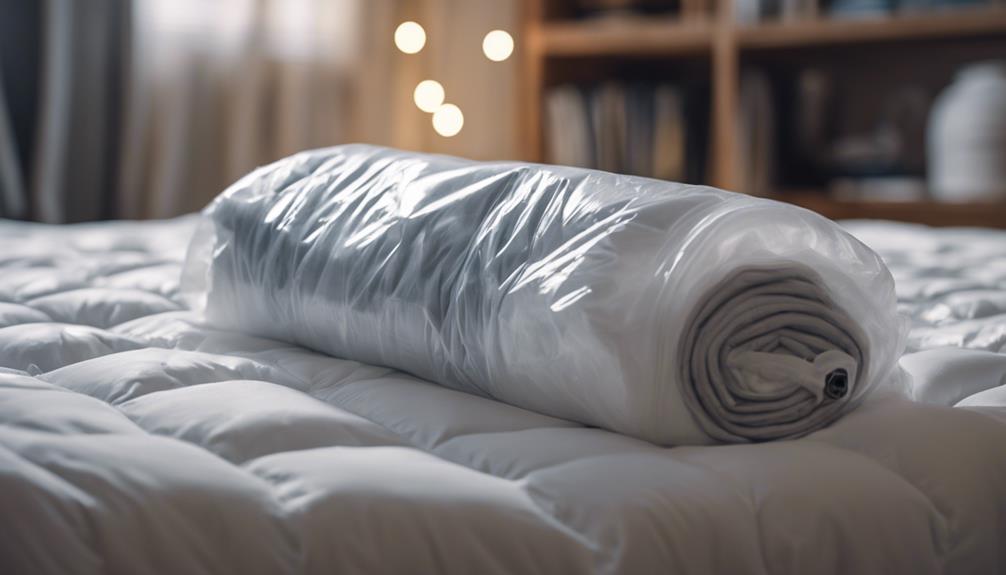
To maintain comforters in ideal condition, consider utilizing large cotton bags for storage, allowing for breathability and preventing compression damage. When storing comforters, it's important to follow proper methods to preserve their quality.
Here are some alternative storage options to keep your comforters in top shape:
- Avoid stacking heavy items: Placing heavy objects on top of comforters can flatten them and affect their fluffiness and insulation properties.
- Use non-compression storage bags: Opt for specialized duvet storage bags that don't compress the comforter filling, such as Neusu's duvet storage bags.
- Opt for acid-free quilt storage boxes: Instead of vacuum seal bags, consider acid-free quilt storage boxes to safeguard comforters from damage.
- Maintain proper environment: Store comforters in a cool, dry place with good airflow to prevent mold, musty odors, and damage.
- Handle with care: When storing or moving comforters, do so gently to avoid unnecessary stress on the fabric and filling.
Preserving Comforter Quality
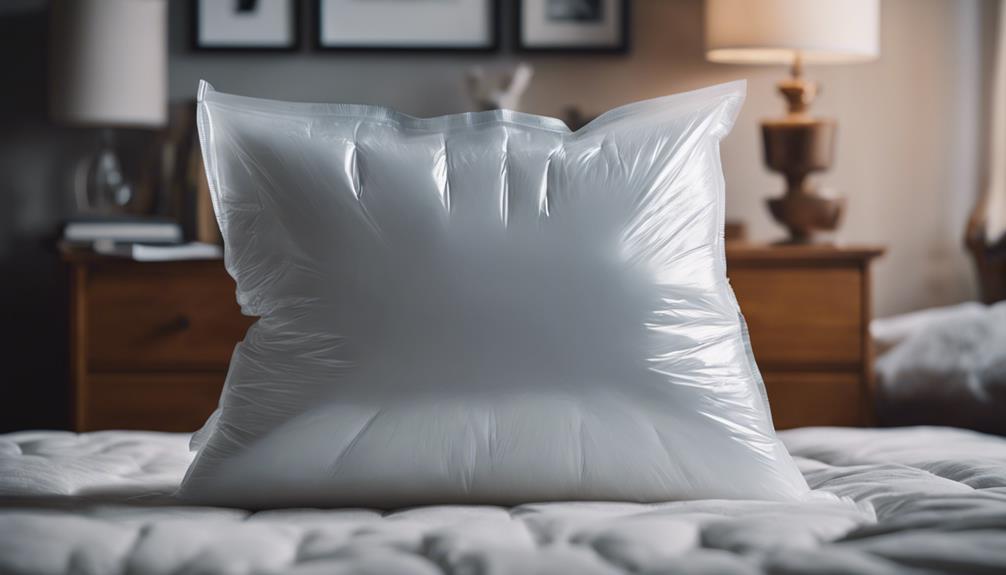
Preserving comforter quality necessitates careful consideration of storage methods that avoid compression and maintain breathability for best longevity. When it comes to storing comforters, using vacuum storage bags may seem like a space-saving solution, but caution is necessary. Over-compressing comforters in vacuum seal bags can lead to reduced fluffiness and insulation effectiveness over time. To prevent damage, make sure to leave some air in the bag when sealing it to avoid excessive pressure on the bedding material. It is recommended to avoid vacuum sealing comforters filled with delicate materials like down or feathers to maintain their original quality and longevity. Opting for alternative storage methods such as cotton bags or breathable storage containers can help preserve the quality of comforters without risking damage. Remember, the key is to find a balance between efficient storage and maintaining the comforter's integrity.
| Proper Method | Effect on Comforter | Recommended Material |
|---|---|---|
| Leave some air in the bag | Prevents excessive compression | Cotton bags or breathable containers |
| Avoid vacuum sealing delicate materials | Maintains original quality | Cotton bags or breathable containers |
| Opt for breathable storage | Preserves comforter quality | Cotton bags or breathable containers |
Avoiding Vacuum-Sealing Mistakes
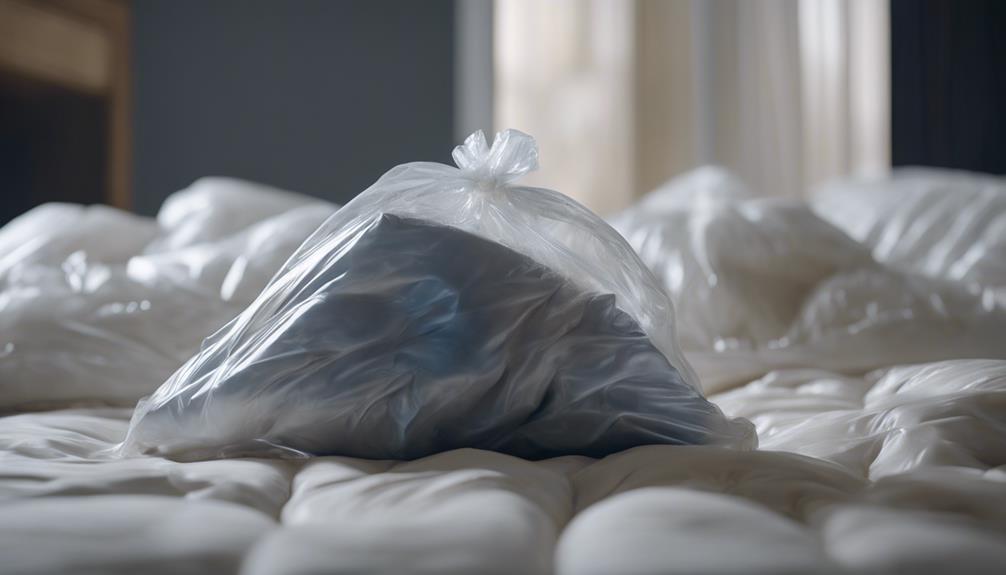
When vacuum-sealing comforters, it's important to avoid excessive compression to prevent damaging the filling and reducing fluffiness over time. Here are some tips to help you avoid common vacuum-sealing mistakes when storing comforters:
- Follow manufacturer guidelines: Be sure to adhere to any recommendations regarding how much air to remove when using vacuum storage bags for your comforter.
- Avoid extended storage: Refrain from leaving comforters in vacuum-seal bags for prolonged periods to prevent permanent damage to the filling.
- Air out the comforter: After removing it from the vacuum-seal bag, shake out and air the comforter to restore its loft and fluffiness.
- Consider alternative storage: If you're concerned about compression, using non-compression storage bags or breathable cotton bags can be a safer option for storing your comforters.
- Monitor fluffiness: Regularly check the fluffiness of your comforter to make sure it's not being overly compressed in the vacuum-seal bag.
Prolonging Comforter Longevity
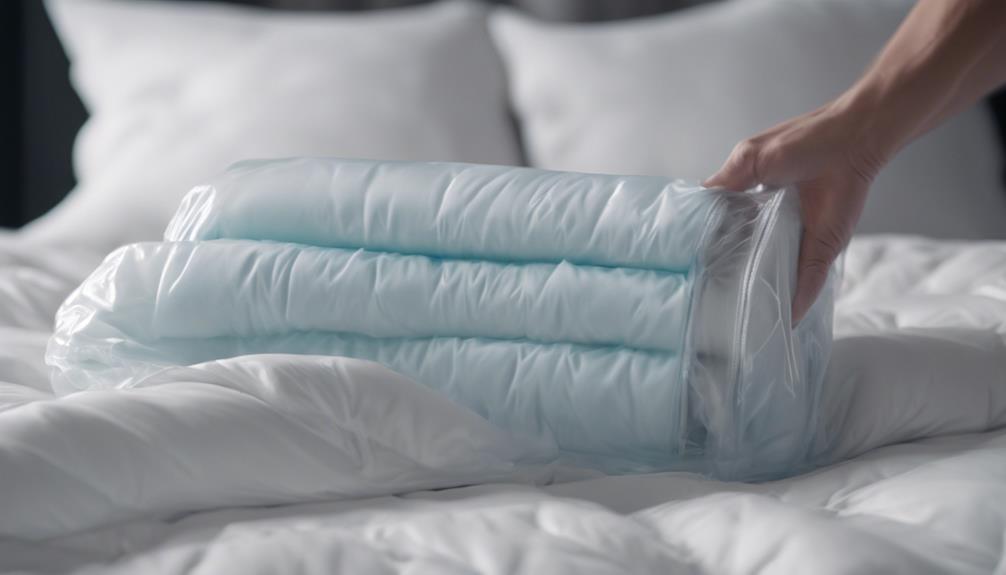
After understanding the risks of compression in vacuum-seal bags for comforters, the focus now shifts to strategies that can prolong the longevity of these bedding essentials. When it comes to storing comforters for extended periods, opting for non-compression storage bags or cotton bags is a wise choice, especially for feather or down-filled comforters. By using vacuum storage bags, it's important to make sure they're properly sealed to prevent over-compression, which can damage the filling and affect the comforter's fluffiness and insulation capabilities. Leaving some air inside the vacuum bags can help maintain the original quality of the comforter.
Additionally, it's important to avoid placing heavy items on top of vacuum-sealed comforters. This practice helps to preserve the loftiness and overall quality of the comforter, ensuring it retains its warmth and coziness over time. By following these simple storage guidelines, you can effectively prolong the longevity of your comforter and continue enjoying its comfort and warmth for years to come.
Frequently Asked Questions
Can You Store Comforters in Vacuum Bags?
Yes, we can store comforters in vacuum bags for short-term storage to save space. However, extended compression in these bags may impact the fluffiness and insulation of the comforter.
It's important to take into account the type of filling in your comforter, as down or feather bedding can be damaged by vacuum sealing over time. For longer-lasting preservation, breathable storage options like cotton bags might be a better choice to maintain comforter quality.
Are Vacuum Bags Good for Bedding?
Vacuum bags are excellent for bedding storage, offering space-saving solutions and protection from odors and moisture. They work well for clean and dry synthetic comforters, helping to maintain their quality.
However, avoid using them for down or feather bedding, as the compression can damage the filling. Opt for non-compression storage bags for feather or down bedding to prevent harm and maintain their integrity.
Do Vacuum Seal Bags Ruin Clothes?
Vacuum seal bags, when used improperly, can indeed ruin clothes. Compression and distortion of fibers are common issues. Delicate fabrics like cashmere and silk are especially vulnerable.
To prevent damage, avoid storing clothes that need to breathe or retain their shape in vacuum seal bags for extended periods. Proper preparation and regular inspection are key to maintaining the quality of clothes stored in vacuum seal bags.
Can You Vacuum Seal Blankets?
Yes, we can vacuum seal blankets to save space efficiently. Vacuum sealing may compress fibers, impacting fluffiness and insulation, especially with delicate materials like down.
Synthetic blankets tend to fare better than natural fibers when vacuum sealed. To maintain blanket quality, consider using breathable cotton bags as an alternative storage method.
Always assess the blanket material before vacuum sealing for best preservation.
Will Vacuum Sealing Ruin My Comforter?
When considering storing your comforter, vacuum sealing is not recommended. The compression can damage the delicate filling and reduce its fluffy texture. Instead, use breathable storage bags or containers to protect and preserve your comforter. Follow these vacuum seal comforter bedding tips to ensure its longevity.
Conclusion
To guarantee, in summary, to contemplate, it's crucial to contemplate vacuum seal bags may seem like a convenient storage solution for comforters, they can actually have negative effects on their fluffiness, insulation, and overall comfort.
It's crucial to ponder alternative storage methods and take steps to preserve the quality and longevity of your comforter. By avoiding vacuum-sealing mistakes and being mindful of long-term warmth and comfort issues, you can make sure that your comforter remains cozy and comfortable for years to come.
